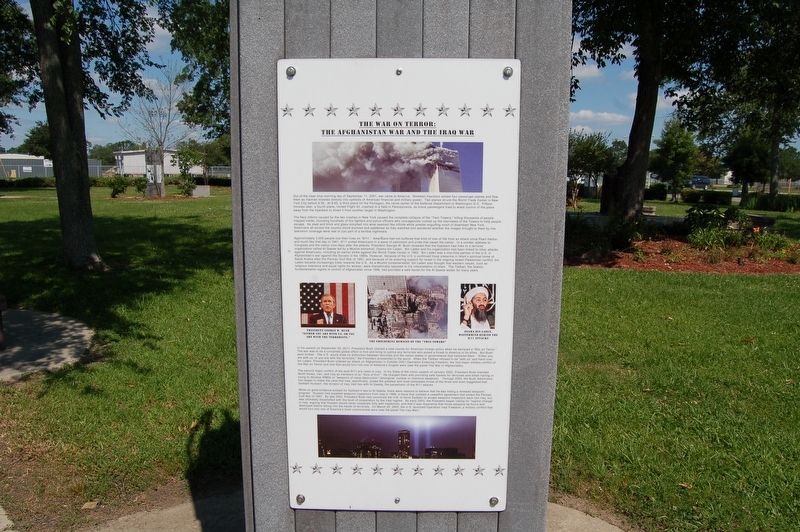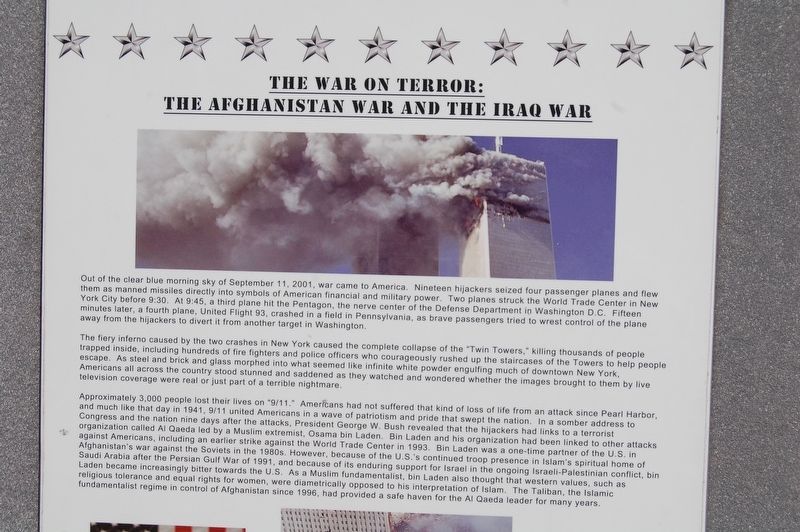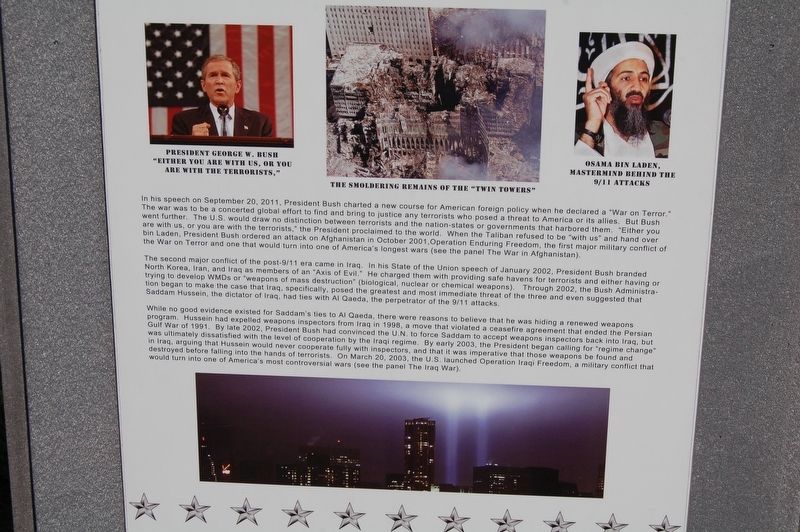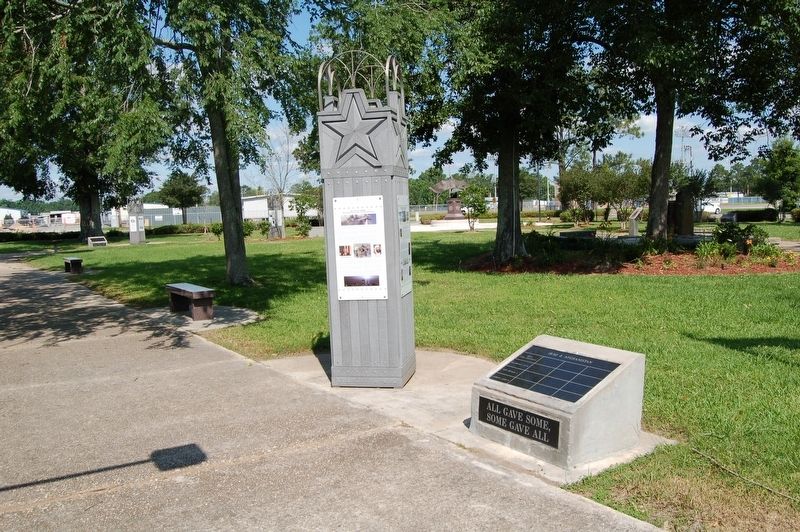Gonzales in Ascension Parish, Louisiana — The American South (West South Central)
The War on Terror: The Afghanistan War And The Iraq War
Out of the clear blue morning sky of September 11, 2001, war came to America. Nineteen hijackers seized four passenger planes and flew them as manned missiles directly into symbols of American financial and military power. Two planes struck the World Trade Center in New York City before 9:30. At 9:45, a third plane hit the Pentagon, the nerve center of the Defense Department in Washington D.C. Fifteen minutes later, a fourth plane, United Flight 93, crashed in a field in Pennsylvania, as brave passengers tried to wrest control of the plane away from the hijackers to divert it from another target in Washington.
The fiery inferno caused by the two crashes in New York caused the complete collapse of the “Twin Towers,” killing thousands of people trapped inside, including hundreds of fire fighters and police officers who courageously rushed up the staircases of the Towers to help people escape. As steel and brick and glass morphed into what seemed like infinite white powder engulfing much of downtown New York, Americans all across the country stood stunned and saddened as they watched and wondered whether the images brought to them by live television coverage were real or just part of a terrible nightmare.
Approximately 3,000 people lost their lives on “9/11." Americans had not suffered that kind of loss of life from an attack since Pearl Harbor, and much like that day in 1941, 9/11 united Americans in a wave of patriotism and pride that swept the nation. In a somber address to Congress and the nation nine days after the attacks, President George W. Bush revealed that the hijackers had links to a terrorist organization called Al Qaeda led by a Muslim extremist, Osama bin Laden. Bin Laden and his organization had been linked to other attacks against Americans, including an earlier strike against the World Trade Center in 1993. Bin Laden was a one-time partner of the U.S. in Afghanistan's war against the Soviets in the 1980s. However, because of the U.S.'s continued troop presence in Islam's spiritual home of Saudi Arabia after the Persian Gulf War of 1991, and because of its enduring support for Israel in the ongoing Israeli-Palestinian conflict, bin Laden became increasingly bitter towards the U.S. As a Muslim fundamentalist, bin Laden also thought that western values, such as religious tolerance and equal rights for women, were diametrically opposed to his interpretation of Islam. The Taliban, the Islamic fundamentalist regime in control of Afghanistan since 1996, had provided a safe haven for the Al Qaeda leader for many years.
In his speech on September 20, 2011, President Bush charted a new course for American foreign policy when he declared a “War on Terror." The war was to be a concerted global effort to find and bring to justice any terrorists who posed a threat to America or its allies. But Bush went further. The U.S. would draw no distinction between terrorists and the nation-states or governments that harbored them. “Either you are with us, or you are with the terrorists,” the President proclaimed to the world. When the Taliban refused to be “with us” and hand over bin Laden, President Bush ordered an attack on Afghanistan in October 2001,Operation Enduring Freedom, the first major military conflict of the War on Terror and one that would turn into one of America's longest wars (see the panel The War in Afghanistan).
The second major conflict of the post-9/11 era came in Iraq. In his State of the Union speech of January 2002, President Bush branded North Korea, Iran, and Iraq as members of an “Axis of Evil." He charged them with providing safe havens for terrorists and either having or trying to develop WMDs or "weapons of mass destruction” (biological, nuclear or chemical weapons). Through 2002, the Bush Administration began to make the case that Iraq, specifically, posed the greatest and most immediate threat of the three and even suggested that Saddam Hussein, the dictator of Iraq, had ties with Al Qaeda, the perpetrator of the 9/11 attacks.
While no good evidence existed for Saddam's ties to Al Qaeda, there were reasons to believe that he was hiding a renewed weapons program. Hussein had expelled weapons inspectors from Iraq in 1998, a move that violated a ceasefire agreement that ended the Persian Gulf War of 1991. By late 2002, President Bush had convinced the U.N. to force Saddam to accept weapons inspectors back into Iraq, but was ultimately dissatisfied with the level of cooperation by the Iraqi regime. By early 2003, the President began calling for “regime change" Hussein would never cooperate fully with inspectors, and that it was imperative that those weapons be found and destroyed before falling into the hands of terrorists. On March 20, 2003, the U.S. launched Operation Iraqi Freedom, a military conflict that would turn into one of America's most controversial wars (see the panel The Iraq War).
Topics and series. This memorial is listed in these topic lists: 9/11 Attacks • War, 2nd Iraq • War, Afghanistan. In addition, it is included in the Former U.S. Presidents: #43 George W. Bush series list.
Location. 30° 13.691′ N, 90° 54.784′ W. Marker is in Gonzales, Louisiana, in Ascension Parish. Memorial can be reached from South Irma Boulevard, 0.3 miles north of East Worthey Street, on the right when traveling north. Touch for map. Marker is in this post office area: Gonzales LA 70737, United States of America. Touch for directions.
Other nearby markers. At least 8 other markers are within walking distance of this marker. Ascension Parish Residents Fighting the War on Terror (here, next to this marker); The War on Terror: The Afghanistan War (here, next to this marker); War on Terror: The Iraq War (here, next to this marker); "The Mother of All Battles Has Begun!" (a few steps from this marker); Louisiana Marines in the Persian Gulf War (a few steps from this marker); The Persian Gulf War (a few steps from this marker); The Freedom Fountain (a few steps from this marker); Purple Heart Memorial (within shouting distance of this marker). Touch for a list and map of all markers in Gonzales.
More about this marker. Located in the Gonzales Veterans Memorial Park
Credits. This page was last revised on October 25, 2021. It was originally submitted on April 1, 2018, by Cajun Scrambler of Assumption, Louisiana. This page has been viewed 232 times since then and 11 times this year. Photos: 1, 2, 3, 4. submitted on April 1, 2018.



